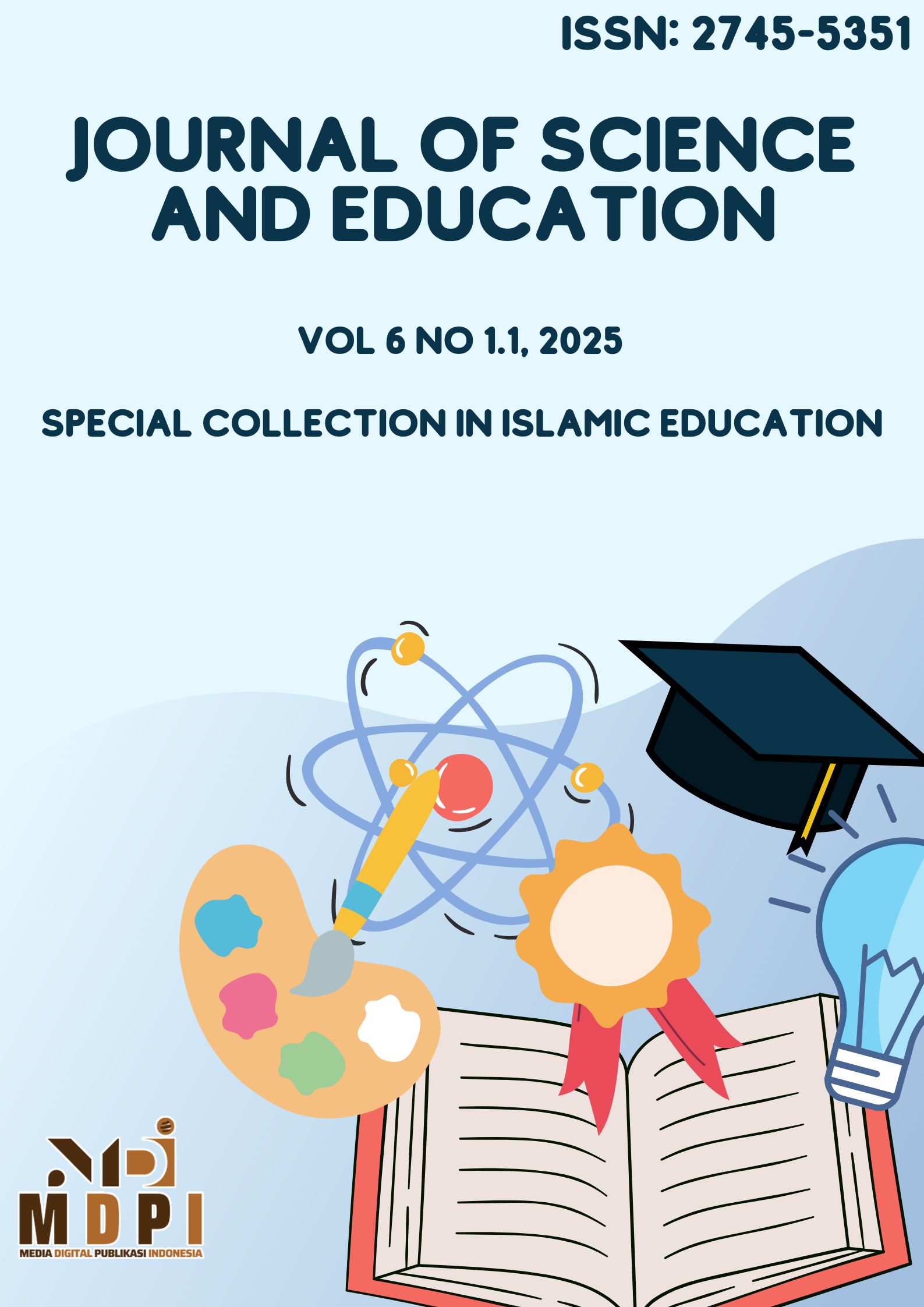The Implementation of Differentiated Instruction in Islamic Religious Education to Enhance Students’ Learning Motivation
DOI:
https://doi.org/10.58905/jse.v6i1.1.610Keywords:
differentiated instruction, learning motivation, Islamic Religious Education, learning styles, elementary school, Merdeka CurriculumAbstract
This study aims to examine the implementation of differentiated instruction in Islamic Religious Education (IRE) as a strategy to enhance elementary school students’ learning motivation. Employing a classroom action research approach with a mixed-methods design, the research was conducted at SDN Leuwiliang and SDN Pelita, both of which have adopted the Merdeka Curriculum. Data were collected through the Motivated Strategies for Learning Questionnaire (MSLQ), classroom observations, in-depth interviews, and documentation of the instructional process. The findings indicate that learning style-based differentiation strategies such as the use of podcasts for auditory learners and worship practice simulations for kinesthetic learners effectively increased student engagement. Content differentiation through the integration of local culture and tiered assignments also significantly reduced the rate of learning incompleteness. Quantitative analysis revealed a significant improvement in intrinsic goal orientation scores (from μ = 2.1 to μ = 3.4) and self-efficacy (from μ = 2.3 to μ = 3.6), with p < 0.018. The successful implementation was further supported by educational technology, teacher collaboration, and principal-led budgeting policies. These findings affirm that differentiated instruction in IRE not only enhances learning motivation but also fosters a more inclusive and contextualized learning experience. The study recommends the development of technical guidelines, reflective training for IRE teachers, and school policies that are responsive to diverse learning needs.
Downloads
References
A. T. Purnawanto, “Pembelajaran berdiferensiasi,” J. Pedagog., vol. 16, no. 1, pp. 34–54, 2023.
R. G. Kurniawan, Pembelajaran Diferensiasi Berbasis Deep Learning: Strategi Mindful, Meaningful, dan Joyful Learning. Penerbit Lutfi Gilang, 2025.
F. Martanti, J. Widodo, R. Rusdarti, and A. S. Priyanto, “Penguatan Profil Pelajar Pancasila Melalui Pembelajaran Diferensiasi Pada Mata Pelajaran IPS di Sekolah Penggerak,” in Prosiding Seminar Nasional Pascasarjana (PROSNAMPAS), 2022, vol. 5, no. 1, pp. 412–417.
S. P. Casmudi, PEMBELAJARAN DIFERENSIASI ABAD 21: Konsep Pembelajaran untuk Memenuhi Kebutuhan Siswa dalam Transformasi Digital. PENERBIT KBM INDONESIA, 2025.
S. S. Miladiah, N. Sugandi, and R. Sulastini, “Analisis Penerapan Kurikulum Merdeka Di SMP Bina Taruna Kabupaten Bandung,” J. Ilm. Mandala Educ., vol. 9, no. 1, 2023.
H. Houtman, “Merdeka Belajar Dalam Masyarakat 5.0,” 2020.
I. Rista, N. Nelson, and A. Amrullah, “Strategi Guru PAI dalam Meningkatkan Motivasi Belajar Peserta Didik pada Kurikulum Merdeka di SMPN 4 Rejang Lebong.” Institut Agama Islam Negeri Curup, 2025.
C. A. Tomlinson, “Differentiated Instruction in the Regular Classroom: What Does It Mean? How Does It Look?.,” Underst. Our Gift., vol. 14, no. 1, pp. 3–6, 2001.
L. M. McQuarrie and P. McRae, “A provincial perspective on differentiated instruction: The Alberta Initiative for School Improvement (AISI),” J. Appl. Res. Learn., vol. 3, no. 4, pp. 1–18, 2010.
S. N. Azizah and A. P. Astutik, “Diferensiasi pembelajaran pendidikan agama Islam dalam meningkatkan literasi di era digital,” JIIP-Jurnal Ilm. Ilmu Pendidik., vol. 8, no. 3, pp. 2905–2915, 2025.
U. F. Lestari, M. Wati, M. Afandi, M. Subhan, and M. D. R. Sahbana, “Strategi Pembelajaran Diferensiasi dalam Pendidikan Agama Islam: Perspektif Psikologis,” J. Educ. Res., vol. 5, no. 4, pp. 5272–5280, 2024.
R. Assya’bani, “ANALISIS PSIKOLOGIS DALAM PENDIDIKAN KEAGAMAAN ISLAM PADA SEKOLAH BERASRAMA (Sebuah Tinjauan Multi Perspektif),” J. Educ. Sociol. Law, vol. 1, no. 2, pp. 1012–1030, 2025.
L. S. Vygotsky and M. Cole, Mind in society: Development of higher psychological processes. Harvard university press, 1978.
J. W. Creswell and V. L. P. Clark, Designing and conducting mixed methods research. Sage publications, 2017.
H. Altrichter, S. Kemmis, R. McTaggart, and O. Zuber‐Skerritt, “The concept of action research,” Learn. Organ., vol. 9, no. 3, pp. 125–131, 2002.
Adrias and A. Ruswandi, Desain Penelitian Kuantitatif, Kualitatif, dan Mix Method. Depok: Rajawali Pers, 2025.
R. K. Yin, Case study research and applications. SAGE Publications US., 2017.
A. Tashakkori and J. W. Creswell, “The new era of mixed methods,” J. Mix. Methods Res., vol. 1, no. 1, pp. 3–7, 2007, doi: 10.1177/2345678906293042.
Y. Lincoln and B. Guba, “Naturalistic inquiry. Beverly Hills: Sage Pulications.” Inc, 1985.
A. K. Shenton, “Strategies for ensuring trustworthiness in qualitative research projects,” Educ. Inf., vol. 22, no. 2, pp. 63–75, 2004.
E. J. Tisdell, S. B. Merriam, and H. L. Stuckey-Peyrot, Qualitative research: A guide to design and implementation. John Wiley & Sons, 2025.
M. B. Miles, A. M. Huberman, and J. Saldaña, Qualitative Data Analysis: A Methods Sourcebook, Third edit. Thousand Oaks: SAGE Publications Inc, 2014.
G. Gay, “Culturally responsive teaching principles, practices, and effects,” in Handbook of urban education, Routledge, 2013, pp. 391–410.
R. Wormeli, “Accountability: Teaching through assessment and feedback, not grading,” Am. Second. Educ., pp. 14–27, 2006.
E. L. Deci and R. M. Ryan, “The" what" and" why" of goal pursuits: Human needs and the self-determination of behavior,” Psychol. Inq., vol. 11, no. 4, pp. 227–268, 2000.
R. Dunn, S. A. Griggs, J. Olson, M. Beasley, and B. S. Gorman, “A meta-analytic validation of the Dunn and Dunn model of learning-style preferences,” J. Educ. Res., vol. 88, no. 6, pp. 353–362, 1995.
johnson, contextual teaching and learning. 2007.
K. U. Mayer, “New directions in life course research,” Annu. Rev. Sociol., vol. 35, no. 1, pp. 413–433, 2009.
R. DuFour, “What is a" professional learning community"?,” Educ. Leadersh., vol. 61, no. 8, pp. 6–11, 2004.
V. Griggs, M. Blackburn, and J. Smith, “The educational scorecard: The Start of our Journey,” Electron. J. Bus. Res. Methods, vol. 10, no. 2, pp. 121–131, 2012.
P. Hallinger and R. H. Heck, “Leadership for learning,” Does Collab. Leadersh. make a Differ., pp. 654–678, 2007.
Downloads
Published
How to Cite
Issue
Section
License
Copyright (c) 2025 Nana Supriatna, Abdul Holik

This work is licensed under a Creative Commons Attribution-ShareAlike 4.0 International License.

















